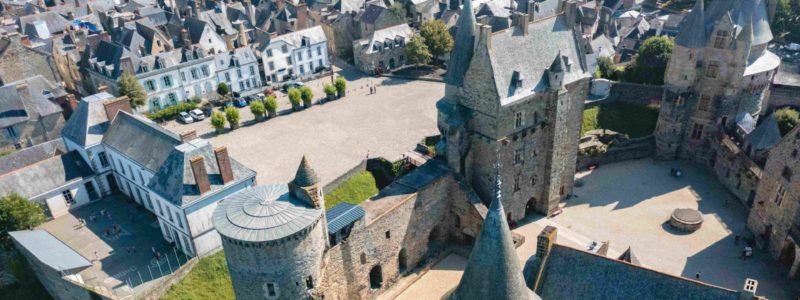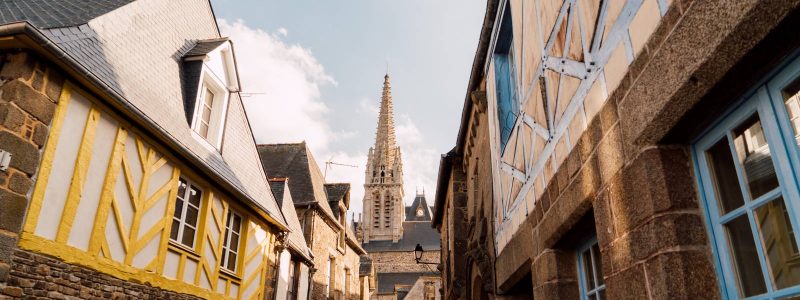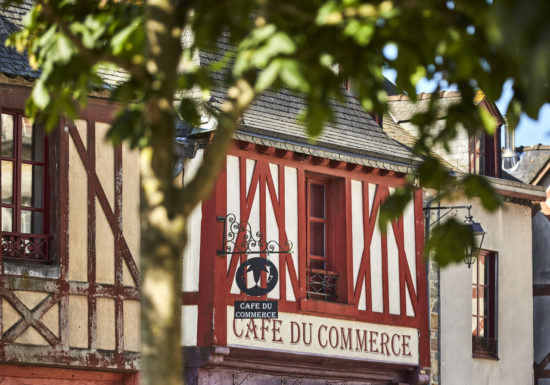The city of La Guerche-de-Bretagne is located on the borders of two regions; Brittany and Pays-de-la-Loire and four departments; Ille-et-Vilaine, Mayenne, Maine-et-Loire and Loire-Atlantique. This strategic location, on the Marches of Brittany, has allowed it to assert itself over the centuries and to be at the heart of trade.
La Guerche was founded in the Middle Ages in the parish of Rannée, to the south of the city, by Sylvestre, from a family of bishops. The simple dungeon, probably in wood, built on a motte, is succeeded by a stone castle, attested in the XNUMXth century, which overlooked the pond of Matz, which has now dried up.
From the XNUMXth century, the city became a real small town, with many half-timbered houses grouped around its castle, and the seat of an important lordship. Thirty-seven lords succeeded one another there, among which, Bertrand du Guesclin who fought against the English during the war of Succession of Brittany.
Due to its strategic location, the city is developing, but it is also very coveted and is the subject of countless occupations, devastations and abuses.
In 1173, the castle and the town were burned down by the troops of Henry II, King of England. In the following century, in order to better protect itself, the city acquired ramparts and the first two gates. This did not prevent the English from forcing the ramparts in 1443 and taking possession of the city. In the XNUMXth century, La Guerche, a Catholic stronghold, was shaken one last time by the Wars of Religion.
In the XNUMXth and XNUMXth centuries, the city continued to open up and the population showed great activity. Agriculture, trade, the tanning of skins, the manufacture of sheets and the canvas industry ensure, in the Guernsey country, prosperity and a certain ease attested by the construction of churches and mansions.
In the 1880th century, the city developed through its suburbs. An effective policy of opening up promotes exchanges, in particular thanks to the creation of a rail network in 1881 and XNUMX.
Today, the city shines on its territory. It has the particularity of having preserved a dense and concentrated urbanization as well as a rare example of half-timbered architecture. Its unmissable market has attracted a large population every Tuesday morning since 1121.
The Small Towns of Character®: Responding to the precise and demanding commitments of a national quality charter, the Small Towns of Character® implement innovative forms of heritage enhancement, public reception and local entertainment. It is throughout the year that they welcome you and invite you to their rich events and other varied appointments. You are invited.
Take the time to visit them, push the doors open to you and appreciate a certain art of living there. Discover them on the Petites Cités de Caractère® website.
Your itinerary
Guerche-de-Bretagne
La Guerche was founded in the Middle Ages in the parish of Rannée, to the south of the city, by Sylvestre, from a family of bishops. The simple dungeon, probably in wood, built on a motte, is succeeded by a stone castle, attested in the XNUMXth century, which overlooked the pond of Matz, which has now dried up.
From the XNUMXth century, the city became a real small town, with many half-timbered houses grouped around its castle, and the seat of an important lordship. Thirty-seven lords succeeded one another there, among which, Bertrand du Guesclin who fought against the English during the war of Succession of Brittany.
Due to its strategic location, the city is developing, but it is also very coveted and is the subject of countless occupations, devastations and abuses.
In 1173, the castle and the town were burned down by the troops of Henry II, King of England. In the following century, in order to better protect itself, the city acquired ramparts and the first two gates. This did not prevent the English from forcing the ramparts in 1443 and taking possession of the city. In the XNUMXth century, La Guerche, a Catholic stronghold, was shaken one last time by the Wars of Religion.
In the XNUMXth and XNUMXth centuries, the city continued to open up and the population showed great activity. Agriculture, trade, the tanning of skins, the manufacture of sheets and the canvas industry ensure, in the Guernsey country, prosperity and a certain ease attested by the construction of churches and mansions.
In the 1880th century, the city developed through its suburbs. An effective policy of opening up promotes exchanges, in particular thanks to the creation of a rail network in 1881 and XNUMX.
Today, the city shines on its territory. It has the particularity of having preserved a dense and concentrated urbanization as well as a rare example of half-timbered architecture. Its unmissable market has attracted a large population every Tuesday morning since 1121.
The Small Towns of Character®: Responding to the precise and demanding commitments of a national quality charter, the Small Towns of Character® implement innovative forms of heritage enhancement, public reception and local entertainment. It is throughout the year that they welcome you and invite you to their rich events and other varied appointments. You are invited.
Take the time to visit them, push the doors open to you and appreciate a certain art of living there. Discover them on the Petites Cités de Caractère® website.




